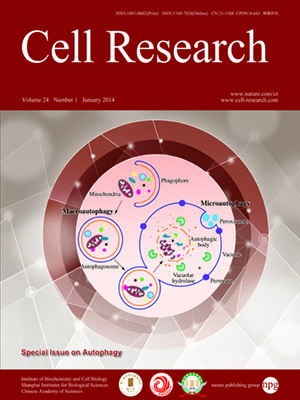
Volume 24, No 1, Jan 2014
ISSN: 1001-0602
EISSN: 1748-7838 2018
impact factor 17.848*
(Clarivate Analytics, 2019)
Volume 24 Issue 1, January 2014: 24-41
REVIEWS
The machinery of macroautophagy
Yuchen Feng1,*, Ding He1,*, Zhiyuan Yao1,* and Daniel J Klionsky1
1Life Sciences Institute and Department of Molecular, Cellular and Developmental Biology, University of Michigan, Ann Arbor, MI 48109, USA
Correspondence: Daniel J Klionsky(klionsky@umich.edu)
Autophagy is a primarily degradative pathway that takes place in all eukaryotic cells. It is used for recycling cytoplasm to generate macromolecular building blocks and energy under stress conditions, to remove superfluous and damaged organelles to adapt to changing nutrient conditions and to maintain cellular homeostasis. In addition, autophagy plays a critical role in cytoprotection by preventing the accumulation of toxic proteins and through its action in various aspects of immunity including the elimination of invasive microbes and its participation in antigen presentation. The most prevalent form of autophagy is macroautophagy, and during this process, the cell forms a double-membrane sequestering compartment termed the phagophore, which matures into an autophagosome. Following delivery to the vacuole or lysosome, the cargo is degraded and the resulting macromolecules are released back into the cytosol for reuse. The past two decades have resulted in a tremendous increase with regard to the molecular studies of autophagy being carried out in yeast and other eukaryotes. Part of the surge in interest in this topic is due to the connection of autophagy with a wide range of human pathophysiologies including cancer, myopathies, diabetes and neurodegenerative disease. However, there are still many aspects of autophagy that remain unclear, including the process of phagophore formation, the regulatory mechanisms that control its induction and the function of most of the autophagy-related proteins. In this review, we focus on macroautophagy, briefly describing the discovery of this process in mammalian cells, discussing the current views concerning the donor membrane that forms the phagophore, and characterizing the autophagy machinery including the available structural information.
10.1038/cr.2013.168
FULL TEXT | PDF
Browse 2272


